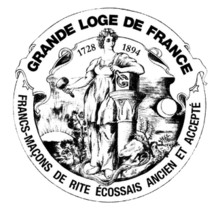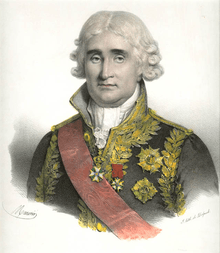Grande Loge de France
The Grande Loge de France (G∴L∴D∴F∴) is the oldest Masonic obedience operating in France with a practice of a spiritualist and initiatory Freemasonry within Tradition.
 | |
| Formation | 1728 |
|---|---|
| Type | Freemasonic Grand Lodge |
| Headquarters | 8, rue Puteaux, 17th arrondissement of Paris |
| Location | |
Grand Master | Pierre-Marie ADAM |
Main organ | PVI - Points de Vue Initiatiques |
Parent organization | Ancient and Accepted Scottish Rite — Suprême Conseil de France |
| Affiliations | Confédération Internationale des Grandes Loges Unies |
| Website | https://www.gldf.org/ |
The Grande Loge de France is centered on the Regularity of its works held under the practice of the Ancient and Accepted Scottish Rite.
It sees itself as occupying a unique position in the landscape of French Freemasonry but maintains certain degrees of relationships with other continental obediences.
As an independant and sovereign Masonic Power, the Grande Loge de France shares its motto Liberté, Egalité, Fraternité with France.
History
Origins of the name and Foundation
The name Grande Loge de France was used by the first French Masonic grand body. Even though the oldest archives are dated 14th May 1737, French Masons had decided in 1728 to recognize Philip, Duke of Wharton (1698-1731) - who lived in Paris and Lyon in 1728 and 1729 and who had been Grand Master of the Grand Lodge of London and Westminster in 1723 - as Grand Master of all Masons in France.[1]
Two other jacobite Grand Masters succeeded him: James Hector MacLean (1703-1750) then Charles Radclyffe, Count of Derwentwater (1693-1746), elected Grand Master of the Order of Free Masons in the Kingdom of France on 27th December 1746.
In the 1738 version, the Constitutions of Anderson mention the existence of a Grand Master and of Lodges in France, setting them equal to the ones of York, Ireland, Scotland and Italy.
In December 1736, Chevalier Andrew Michael Ramsay (1686-1743) delivered a reception Discourse elaborating on the connection between Freemasonry and the Crusader knights, a discourse which will influence greatly the development of several side Degrees over the period 1740-1770 in France.
Following the death of the Grand Master of all Regular Lodges in France Louis de Pardaillan de Gondrin, Duc d'Antin, is successor Louis, Count of Clermont (1709-1771), blood Prince Bourbon-Condé and future member of the Académie française is elected on 11th December 1743.
In the following years, many additional "Scottish" High Degrees are redacted in France and put in practise in Bordeaux, Lyon and Marseille. The Grande Loge de France does not take part in their development but recognizes them as of 4th July 1755 in its General Bylaws, acknowledging different priviledges to Scottish Masters.
In 1773, a large number of its Lodges gave themselves a new set of Statutes thus creating the Grand Orient de France. However, several parisian Masters and several Lodges of province objected to one of the new Statutes articles which stipulated that the Masters must be elected by the free-choice of their Lodge: they decided to pursue working under the name Grande Loge de Clermont named after its Grand Master who had died in 1771.
The French Revolution forced the Grande Loge de Clermont to suspend its activities in November 1792. After the Terror, they will resume on 17th Ocotber 1796 with only 10 Lodges in Paris and 8 in the provinces. The Grand Orient de France has had its number of Lodges also drastically reduced. It was able to resume its activities a bit later on 24th February 1797. Alexandre Roëttiers de Montaleau was appointed Great Worshipful Master to operate the merger between the Grande Loge de Clermont and the Grand Orient de France on 10th June 1799.
Pursuing its path for reformation, the Grand Orient de France then reorganized its system of High Degrees of the French Rite, defined in seven degrees. In its general circular dated 12th November 1802, the Grand Orient de France prohibited the practice of any other system of High Degrees to all its member Lodges.
The Scottish Rite in France between 1804 and 1894

In 1804, Alexandre Francois Auguste de Grasse, Count de Grasse-Tilly recently arrived in Paris brings news of the birth of the Ancient and Accepted Scottish Rite in the United States in 1801, a Rite based on the Scottish Degrees originating from French Antilles.
He received a warm welcome and founded on 22nd September 1804 the first continental Supreme Council of the Ancient and Accepted Scottish Rite which enhanced the transformation of Lodges recently aggregated around « Saint-Alexandre d’Écosse » into a news symbolic Obedience in charge of the first three Degrees: the « Grande Loge Générale Ecossaise ». The « Grande Loge Générale Ecossaise » elected Prince Louis Bonaparte as its first Grand Master. However, Napoléon I, Emperor of the French imposed its merger with the Grand Orient de France on 5th December 1804 under the authority of Jean-Jacques-Régis de Cambacérès.
Recent History of the Grande Loge de France
The current Grande Loge de France (G∴L∴D∴F∴) was revived in 1894 when the Scottish Rite masonic streams were unified. Priviledges to fully administrate the first Three Degrees of Ancient and Accepted Scottish Rite were granted by the Suprême Conseil de France in 1904.
In 1954 the Convent of the G∴L∴D∴F∴ (General Assembly) voted a resolution which rendered mandatory the presence of the Volume of the Sacred Law in all its Lodges.
The Grande Loge de France works the first three degrees of the Ancient and Accepted Scottish Rite (A&ASR). As of 2020 it accounts with 930 Lodges and over 33,000 members.
Principles and Governance
Principles of Freemasonry
The Grande Loge de France imposes the strict observance of the fundamental following principles:
- Invocation to the Great Architect of the Universe,
- Presence in Lodge of the Three Great Lights: the Volume of the Sacred Law (Bible) opened and exposed with the Square and the Compass,
- Exclusive sovereignty over the Symbolic Degrees
- Total independance of any other structure including of High Degrees
- Male-only attendance in all Ritual works
- Exemption of any political or religious discussion in the Lodge
- Progressive and Spiritual approach to the initiatory process
As such, the Grande Loge de France operates in the respect of fundamental Principles of traditional Freemasonry.
It refers constantly to the motto Ordo Ab Chao of the Ancient and Accepted Scottish Rite.
Governance
The Grande Loge de France is governed by a Federal Counsel of 33 members elected by the Representative of each of the 930 Lodges during the annual Convent (General Assembly). The duration of the charge is 3 years. The Federal Counsel is presided by the Grand Master also elected by the Convent for the same duration of mandate.
Since June 2018, the Grand Master of Grande Loge de France is Pierre-Marie ADAM.
The Grande Loge de France is defined by its Constitution and General Bylaws which apply to all members of the Obedience.
Grande Loge de France outside France
The Grande Loge de France has 36 lodges in 17 countries outside France[2] as a result of history (Lodges in former French colonies) or when no Amity between a foreign Grand Lodge and the Grande Loge de France yet existed in the country at the time of the foundation.
- Belgium: Two lodges in Tournai and Baisieux
- Canada: One lodge in Montreal
- Cambodia: One lodge in Phnom Penh
- Congo: Ten lodges in Brazzaville, Dolisie, Goma, Kimshasa and Pointe Noire
- Costa Rica: One lodge in San Jose
- Dominican Republic: One lodge in Saint Domingue
- England: One lodge in London[3]
- Israel: One lodge in Jerusalem, one lodge in Tel Aviv
- Lithuania: One lodge in Kaunas
- Madagascar: One lodge in Antananarivo
- Mauritius: Six lodges in Grand Baie, Pamplemousses, Port-Louis, Saint-Pierre and Vacoas.
- Poland: One lodge in Warsaw
- Russia: One lodge in Moscow
- Senegal: Three lodges in Dakar and Saly Portudal
- Spain: One lodge in Barcelona[4]
- Thailand: One lodge in Bangkok, one lodge in Phuket
- Vietnam: One lodge in Ho-Chi Mihn
International Confederation of United Grand Lodges of Ancient and Accepted Scottish Rite
In 2000, together with other European Grand Lodges, the Traditional and Symbolic "Opera" Grand Lodge (G∴L∴T∴S∴O∴) and the G∴L∴D∴F∴ formed the Confederation of the United Grand Lodges of Europe.[5]
As of 2020, the structure evolved and became the International Confederation of United Grand Lodges of Ancient and Accepted Scottish Rite with 30 constituent members:
- Grand Lodge of Bulgaria
- Grande Loge Unie du Cameroun
- Gran Logia de Canarias
- Grand Lodge of Czech Republic
- Gran Logia Escosesa de Colombia
- Grande Loge Unie de Cote d'Ivoire
- Gran Logia de Ecuador A&ASR
- Gran Logia General de Espana
- Grande Loge de France
- Grande Loge Symbolique du Gabon
- Grand Lodge of Greece A&ASR
- United Grand Lodge of Greece A&ASR
- Grand Lodge of Hungary A&ASR
- Grand Lodge of South India
- Serenissima Gran Loggia d'Italia
- United Grand Lodge of Latvia
- Grande Loge Unie du Liban
- Grande Loge Unie du Maroc
- National Grand Lodge of Moldova
- Gran Logia de Mexico A&ASR
- Gran Logia de Libres y Aceptados Masones de Paraguay
- Gran Logia Nacional de Filipinas
- National Grand Lodge of Romania
- United Grand Lodge of Russia [6][7]
- Gran Logia Simbolica del Salvador
- National Grand Lodge of Serbia
- Regular Grand Lodge of Slovenia
- Mexican Grand Lodge of Texas A&ASR
- Grande Loge du Togo
- Gran Oriente de Uruguay
Bibliography
- Connaître la Grande Loge de France, édit. Ivoire Clair, collection Les Architectes de la Connaissance dirigée par Philippe Morbach, Paris, 2000 ISBN 2-913882-06-4
- Daniel Ligou (dir.), Histoire des Francs-Maçons en France, tome 2, 1815-2000, Privat, Toulouse, 2000 ISBN 2-7089-6839-4
References
- Ligou, Daniel (2000). Histoire des francs-maçons en France, vol. 1. Privat. ISBN 978-2-7089-6838-7.
- "GLDF in the world".
- The White Swan Lodge, No 1348
- "Inicio". www.elcentrodelaunionescocesa.org.
- "The New United Grand Lodges of Europe". 15 July 2007. Archived from the original on 15 July 2007.
- "News on UGLR official site (Russian)". Archived from the original on 2012-10-27. Retrieved 2010-06-12.
- Иванов С. «Исторический союз русских лож» СПб.: АИР. 2011.- 520 с.: ISBN 978-5-9902797-1-1
